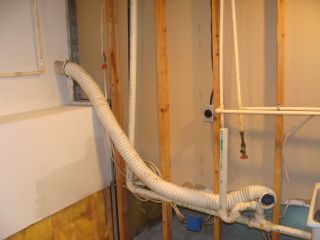The U.S. Consumer Product Safety Commission estimates that in 1998, there were 15,600 fires related to clothes dryers. These fires caused 20 deaths and 370 injuries. Dryer ducts are one of the items that I most commonly find problems with when I inspect homes, but keeping your dryer safe is usually an easy thing to do. The two problems I find are improper installations and lack of maintenance.
Improper installations on dryer ducts are rampant. The most obvious, and possibly most common defect, is plastic dryer ducts. Plastic is not allowed for dryer ducts because lint can easily accumulate in the duct when it sags, and plastic will not contain a fire.


Flexible foil ducts are allowed, but these are little better than plastic. Any plastic dryer ducts should be considered a potential fire hazard, and should be replaced with rigid metal. If flexible material must be used, a maximum of eight feet is allowed. Use the metal type, like the kind pictured below.

Another common installation defect is the length of the ducting. The Minnesota State Mechanical Code states that dryer ducts may be no longer than 25 feet, and for each 90 degree turn, you subtract 5 feet. Most dryer ducts make a 90 degree turn as soon as the duct comes out of the dryer, run up to the ceiling about 8 feet, and then make another 90 degree turn at the ceiling. This adds up to 18 feet, and the duct hasn’t even run horizontally yet! Some dryers are designed for longer ducts, and the code allows a longer run if the dryer is made for it, but you need to check the dryer installation instructions.
I find most problems with the length of dryer ducts at condos and townhouses, but I have also come across a few interesting solutions recently. At a condo in Saint Louis Park, the placard pictured below was attached to the wall – I was very impressed! At a condo building in Saint Paul, an inline pressure-activated fan had been installed in the dryer duct to allow the duct to be much longer than 25 feet. Sorry for the picture quality – I only had my phone with me when I came across this.



I once inspected a dryer exhaust at a 20 year old townhouse because the homeowner complained that their clothes got very hot in the dryer, but never dried. I found about three inches of lint packed at the exhaust because a screen was clogging it! Clean the lint filter between each load, and clean your dryer duct periodically, or have the cuct cleaned professionally.
Reuben Saltzman, Structure Tech Home Inspections - Email - Minneapolis Home Inspections
Improper installations on dryer ducts are rampant. The most obvious, and possibly most common defect, is plastic dryer ducts. Plastic is not allowed for dryer ducts because lint can easily accumulate in the duct when it sags, and plastic will not contain a fire.
I find most problems with the length of dryer ducts at condos and townhouses, but I have also come across a few interesting solutions recently. At a condo in Saint Louis Park, the placard pictured below was attached to the wall – I was very impressed! At a condo building in Saint Paul, an inline pressure-activated fan had been installed in the dryer duct to allow the duct to be much longer than 25 feet. Sorry for the picture quality – I only had my phone with me when I came across this.
The last common problem I’ll discuss is blocked or clogged ducts. This is typically caused by ducts made of improper material or ducts that are too long getting clogged with lint, but can be prevented with regular maintenance. If there is a screen cover at the dryer exhaust (such as the one pictured below), remove it – these are unnecessary on dryers, and they are not allowed.

I once inspected a dryer exhaust at a 20 year old townhouse because the homeowner complained that their clothes got very hot in the dryer, but never dried. I found about three inches of lint packed at the exhaust because a screen was clogging it! Clean the lint filter between each load, and clean your dryer duct periodically, or have the cuct cleaned professionally.
Reuben Saltzman, Structure Tech Home Inspections - Email - Minneapolis Home Inspections

No comments:
Post a Comment